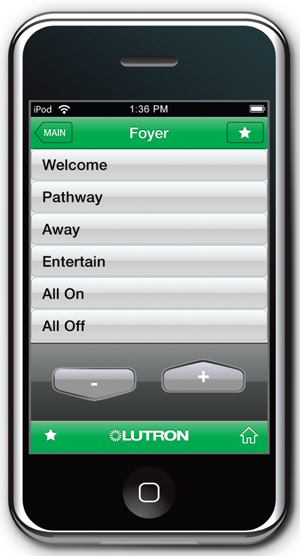An interesting thing happened when Sonos launched a new application for its wireless multiroom audio system last fall. People stopped buying the company’s handheld touchscreen controller. They didn’t need it anymore. The new application allowed them to control the music from their iPhone.
By using Apple’s iPhone—or its cousin, the iPod Touch—as the exclusive controller for the system, homeowners can lower the entry point to multiroom audio, and that’s just fine with Sonos. “It essentially reduces the cost of getting started with us,” according to Sonos co-founder Tom Cullen, who says new customers are starting off with a one-room setup and later adding more rooms of music without buying any Sonos controllers. “We believe there’s a trend pointing toward the iPhone as a way for smaller companies to introduce themselves to a mass audience—the iPhone-lovers.”
Sonos isn’t the only one exploiting the control capabilities of the iPhone and the iPod Touch. Lutron Electronics Co. has introduced an iPhone/iPod Touch application for its HomeWorks lighting-control system, and SE2 Labs is readying an iPhone application for its ITC One integrated home theater controller. It’s a given that Savant Systems’ ROSIE home entertainment and control system, based on the Apple operating system, has iPhone control capability. The list will undoubtedly multiply fast.
Why the rush to the iPhone? “With home control up until now, people were careful about how many controllers they put in the house,” Cullen says. Touchscreen controllers traditionally have been a significant investment for homeowners, with Sonos’ $399 handheld model at the low end of a price scale that goes well into four figures. “Home control was done by shared devices that were relatively expensive and had a fairly sizable startup hurdle you had to clear with setup and installation,” he says. “We’ve gone to where essentially everyone can have a personal controller.”
Consumers can start with a $349 Sonos box for a one-room system, download the iPhone application from the iTunes Web site, and have control over the music on their PCs, Internet radio stations, satellite radio, and other music sites for a very affordable buy-in price. They can add rooms to the modular system, as they can afford to, for $349 to $499 per zone.
Far beyond just the music opportunities, the iPhone application represents a major development in digital platforms across the residential platform, Cullen maintains. “Controlling music is one element,” he says. If people can mute a room from their iPhone, why not dim the lights and turn up the temperature a few degrees too?
Lutron agrees. The lighting-control company recently launched an iPhone/iPod Touch application that’s available for free from the Apple Web site, although consumers likely will have to pay a nominal programming fee to have the application integrated with their HomeWorks lighting-control system.
“The iPhone is reaching into the HomeWorks processor and using a capability called Web keypads,” says Phil Scheetz, Lutron’s home systems marketing manager. Web keypads allow installers to use either Web representations of the keypads in the home or virtual keypads that can have different configurations from the home’s existing keypads. Up to 40 keypads can be selected for control by the iPhone.



